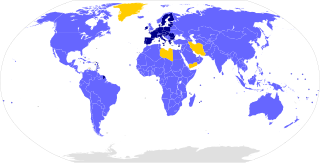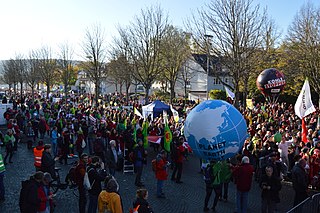Related Research Articles
The United Nations Framework Convention on Climate Change (UNFCCC) established an international environmental treaty to combat "dangerous human interference with the climate system", in part by stabilizing greenhouse gas concentrations in the atmosphere. It was signed by 154 states at the United Nations Conference on Environment and Development (UNCED), informally known as the Earth Summit, held in Rio de Janeiro from 3 to 14 June 1992. Its original secretariat was in Geneva but relocated to Bonn in 1996. It entered into force on 21 March 1994.

Climate change is having major effects on the Chinese economy, society and the environment. China is the largest emitter of carbon dioxide, through an energy infrastructure heavily focused on coal. Other industries, such as a burgeoning construction industry and industrial manufacturing, contribute heavily to carbon emissions. However, like other developing countries, on a per-capita basis, China's carbon emissions are considerably less than countries like the United States. It has also been noted that higher-income countries have outsourced emissions-intensive industries to China. On the basis of cumulative CO2 emissions measured from 1751 through to 2017, China is responsible for 13% globally and about half of the United States' cumulative emissions.
In political ecology and environmental policy, climate governance is the diplomacy, mechanisms and response measures "aimed at steering social systems towards preventing, mitigating or adapting to the risks posed by climate change". A definitive interpretation is complicated by the wide range of political and social science traditions that are engaged in conceiving and analysing climate governance at different levels and across different arenas. In academia, climate governance has become the concern of geographers, anthropologists, economists and business studies scholars.

The Paris Agreement, often referred to as the Paris Accords or the Paris Climate Accords, is an international treaty on climate change. Adopted in 2015, the agreement covers climate change mitigation, adaptation, and finance. The Paris Agreement was negotiated by 196 parties at the 2015 United Nations Climate Change Conference near Paris, France. As of February 2023, 195 members of the United Nations Framework Convention on Climate Change (UNFCCC) are parties to the agreement. Of the three UNFCCC member states which have not ratified the agreement, the only major emitter is Iran. The United States withdrew from the agreement in 2020, but rejoined in 2021.

The Sustainable Development Goals (SDGs) or Global Goals are a collection of seventeen interlinked objectives designed to serve as a "shared blueprint for peace and prosperity for people and the planet, now and into the future." The short titles of the 17 SDGs are: No poverty, Zero hunger, Good health and well-being, Quality education, Gender equality, Clean water and sanitation, Affordable and clean energy, Decent work and economic growth, Industry, innovation and infrastructure, Reduced inequalities, Sustainable cities and communities, Responsible consumption and production, Climate action, Life below water, Life on land, Peace, justice, and strong institutions, and Partnerships for the goals.

A nationally determined contribution (NDC) or intended nationally determined contribution (INDC) is a non-binding national plan highlighting climate change mitigation, including climate-related targets for greenhouse gas emission reductions. These plans also include policies and measures governments aim to implement in response to climate change and as a contribution to achieve the global targets set out in the Paris Agreement.

The 2016 United Nations Climate Change Conference was an international meeting of political leaders and activists to discuss environmental issues. It was held in Marrakech, Morocco, on 7–18 November 2016. The conference incorporated the twenty-second Conference of the Parties (COP22), the twelfth meeting of the parties to the Kyoto Protocol (CMP12), and the first meeting of the parties to the Paris Agreement (CMA1). The purpose of the conference was to discuss and implement plans about combatting climate change and to "[demonstrate] to the world that the implementation of the Paris Agreement is underway". Participants work together to come up with global solutions to climate change.

Action for Climate Empowerment (ACE) is a term adopted by the United Nations Framework Convention on Climate Change (UNFCCC). It refers to Article 6 of the Convention's original text (1992), focusing on six priority areas: education, training, public awareness, public participation, public access to information, and international cooperation on these issues. The implementation of all six areas has been identified as the pivotal factor for everyone to understand and participate in solving the complex challenges presented by climate change. The importance of ACE is reflected in other international frameworks such as the Sustainable Development Goals ; the Global Action Programme for Education for Sustainable Development ; the Aarhus Convention (2011); the Escazú Agreement (2018) and the Bali Guidelines (2010).

The 2017 United Nations Climate Change Conference (COP23) was an international meeting of political leaders, non-state actors and activists to discuss environmental issues. It was held at UN Campus in Bonn, Germany, during 6–17 November 2017. The conference incorporated the 23rd Conference of the Parties to the United Nations Framework Convention on Climate Change (UNFCCC), the thirteenth meeting of the parties for the Kyoto Protocol (CMP13), and the second session of the first meeting of the parties for the Paris Agreement.
Article 6 of the Paris Agreement on climate change enables Parties to cooperate in implementing their nationally determined contributions (NDCs). Among other things, this means that emission reductions can be transferred between countries and counted towards NDCs. Agreement on the provisions of Article 6 was reached after intensive negotiations lasting several years.
Four high level forums on aid effectiveness were held between 2003 and 2011 as part of a "continuous effort towards modernising, deepening and broadening development co-operation and the delivery of aid" coordinated through the OECD. They took place at Rome (2003), Paris (2005), Accra (2008) and Busan (2011).
The Talanoa Dialogue was a process designed to help countries implement and enhance their Nationally Determined Contributions by 2020. The Dialogue was mandated by the Parties to the United Nations Framework Convention for Climate Change to take stock of the collective global efforts to reduce the emissions of greenhouse gases, in line with the goals of the Paris Agreement, which is to limit the rise in average global temperature to 2°C (3.6°F) above pre-industrial levels, and to pursue efforts to limit the increase to 1.5°C (2.7°F).
The 2018 United Nations Climate Change Conference, more commonly referred to as the Katowice Climate Change Conference or COP24, was the 24th Conference of the Parties to the United Nations Framework Convention on Climate Change. It was held between 2 and 15 December 2018 in Katowice, Poland. The conference was held in the International Congress Centre. The president of COP24 was Michał Kurtyka. The conference also incorporated the fourteenth meeting of the parties for the Kyoto Protocol (CMP14), and the third session of the first meeting of the parties for the Paris Agreement which agreed on rules to implement the Agreement. The conference's objective was to have a full implementation of the Paris agreement.
Ecosystem-based adaptation (EBA) encompasses a broad set of approaches to adapt to climate change. They all involve the management of ecosystems and their services to reduce the vulnerability of human communities to the impacts of climate change. The Convention on Biological Diversity defines EBA as "the use of biodiversity and ecosystem services as part of an overall adaptation strategy to help people to adapt to the adverse effects of climate change".
The Enhanced Transparency Framework (ETF) for action and support is a central component to the design, credibility and operation of the Paris Agreement. The framework specifies how parties to the agreement must report on progress in climate change mitigation, adaptation measures and support provided or received. It also provides for international procedures for the review and evaluation of those reports.

Sustainable Development Goal 13 is to limit and adapt to climate change. It is one of 17 Sustainable Development Goals established by the United Nations General Assembly in 2015. The official mission statement of this goal is to "Take urgent action to combat climate change and its impacts". SDG 13 and SDG 7 on clean energy are closely related and complementary.

Carbon quantitative easing (CQE) is an unconventional monetary policy that is featured in a proposed international climate policy, called a global carbon reward. A major goal of CQE is to finance the global carbon reward by managing the exchange rate of a proposed representative currency, called a carbon currency. The carbon currency will be an international unit of account that will represent the mass of carbon that is effectively mitigated and then rewarded under the policy. The carbon currency will function primarily as a store of value and not as a medium of exchange.
The Task Force on Climate Related Financial Disclosures (TCFD) provides information to investors about what companies are doing to mitigate the risks of climate change, as well as be transparent about the way in which they are governed. It was established in December 2015 by the Group of 20 (G20) and the Financial Stability Board (FSB), and is chaired by Michael Bloomberg. It consists of governance, strategy, risk management, and metrics and targets. It will become mandatory for companies to report on these disclosures by 2025 in the UK, although some companies will have to report earlier.

Pledge and review is a method for facilitating international action against climate change. It involves nations each making a self-determined pledge relating to actions they expect to take in response to global warming, which they submit to the United Nations. Some time after the pledges have been submitted, there is a review process where nations assess each other's progress towards meeting the pledges. Then a further round of enhanced pledges can be made, and the process can further iterate.
References
- ↑ Technical dialogue of the first global stocktake. Synthesis report by the co-facilitators on the technical dialogue. unfccc.int (Technical report). Retrieved 2023-11-27.
- ↑ Paris Agreement, Article 4.2
- ↑ Bodansky, D. (2016), The Legal Character of the Paris Agreement. Review of European, Comparative & International Environmental Law, pp. 142-150, doi:10.1111/reel.12154
- ↑ Paris Agreement, Art. 4.3
- ↑ "What is Global Stocktake?". The Indian Express. 2015-12-16. Retrieved 2020-04-08.
- 1 2 "Key Points of the Paris Climate Pact". The New York Times. 2015-12-12. ISSN 0362-4331 . Retrieved 2020-04-08.
- ↑ Paris Agreement, Art. 14
- 1 2 Friedrich, J. (2017), D. R. Klein, M. P. Carazo, M. Doelle, J. Bulmer, & A. Higham (ed.), "Global Stocktake (Article 14)", The Paris agreement on climate change: Analysis and commentary, Oxford, United Kingdom: Oxford University Press., pp. 321-337.
- ↑ Northrop, E., Dagnet, Y., Höhne, N., Thwaites, J., & Mogelgaard, K. (2018), Achieving the ambition of Paris: Designing the Global Stocktake.
- ↑ Paris Agreement, Art. 14.1
- ↑ Decision 19/CMA.1, para 3.
- ↑ Decision 19/CMA.1, para 37.
- ↑ Decision 19/CMA.1, para 23.